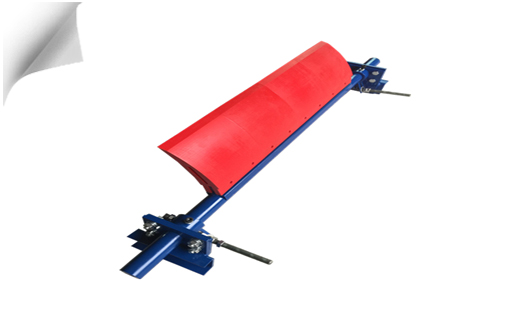
Over the years, the cleaning of conveyor belts has been a major problem in most plants. Many attempts have been made to develop conveyor belt scrapers and cleaners which would solve the problem of carry-back once and for all. Many belt cleaning products simply don’t satisfy client’s requirements, while those that do, involve costly specialist service contracts.
In selecting a good belt scraper several factors must be considered:
After the material has been discharged, particles adhering to the belt (carry-back) must be removed to prevent spillage along the conveyor and material build-up on the return rollers and around the tail drum. Failure to prevent this carry-back will usually result in tracking issues and damage to the belt edges. Material spillage around the conveyor (typically at transfer points) means extra maintenance and clean-up costs.
Below follows a description of some commonly used types of belt cleaning devices, their area of use and function.
1. Primary Scraper/Cleaner
A Primary Scraper is normally positioned against the drive drum immediately below the flow of material. As a rule of thumb says that the lower the belt speed, the lower the cleaner should be mounted and the higher the belt speed, the higher the cleaner can be mounted against the drum.
This is to ensure that the cleaner isn’t hit by the discharging material flow. The Primary Scraper has a tough task. It removes most of the material that adheres to the belt after unloading. This scraper is especially suitable when coarse or moist and sticky material is transported.
2. Secondary Scraper/Cleaner
Secondary cleaners are available in a number of different designs. What they all have in common, is that they are installed immediately behind the drive pulley. This means that greater tension can be applied to a secondary scraper, as it pushes the belt up behind the drum if necessary, to achieve the best possible cleaning finish.
Secondary cleaners are normally used in combination with a Primary Scraper for the highest cleaning efficiency, but they can also be used as standalone if the material transported is dry and fine.
No matter how sophisticated a belt cleaner may be, there are certain conditions that have to be fulfilled in order to give it a fair chance of working well. The following factors affect the efficiency and the wear life of a belt cleaner:
a) The condition of the belt
As demands are put on the condition of the belt cleaner, certain demands must also be put on the belt. In the first place, the belt must be in such condition that it is possible to scrape the adhering particles off it.
The cleaning efficiency is reduced if the belt is old or if its surface is worn or damaged. It is also important to check that the belt splice/joint is smooth to avoid the belt cleaner getting stuck.
b) Maintenance
Like with all equipment in a plant, you are recommended to check and maintain the belt cleaner on a regular basis. If the blades are worn out, the efficiency drops and the spillage increases. The blades should therefore be replaced regularly. In many designs the blade-to-belt contact pressure diminishes as the blades are wearing.
When the pressure gets low, the risk of fine material passing between the blade and the belt increases. When this occurs, spillage along the conveyor as well as the wear rate on the blade increases dramatically. It is therefore very important to make sure that the blade-to-belt contact pressure is correct.
c) Transported material
Belt conveyors are used in many industries. Everything from wood chips, through recycled paper and garbage to iron pellets and crushed rock is moved with the help of conveyors. Obviously the characteristics of the transported material such as its hardness, shape and abrasiveness affect the wear life and efficiency of the belt cleaner.
d) Choice of Scraper/Cleaner
It is important that the right type of scraper/cleaner is chosen, depending on the application required. The wrong choice of product can result in a shorter wear life or insufficient cleaning efficiency. Available space or other factors like temperature and working environment can also determine the choice of product. If you’re not sure, there are Conveyor specialists who can advise you.
e) Incorrect installation
A belt cleaner can only function if it is installed in the correct way and in the right location. Both the efficiency and wear life may be considerably reduced if the belt cleaner is incorrectly installed. A safeguard to ensure successful installation is to have experienced service technicians do the installation and adjustment of the belt cleaner.
Service and maintenance increases the profitability
One of the most important things after every scraper installation is to do regular inspections and maintenance. When the scraper system has been mounted routines must be established for servicing and maintaining the system, which is a precondition for the system to remain efficient over a long period of time and consequently increases the profitability of the plant.
As shown in this article it is undeniable that clean belts are not merely a question of aesthetics, but make it a massive contribution to more up-time, longer wear life and reduced clean-up and maintenance costs.
If you found this article helpful, please share and like it so others can too.

